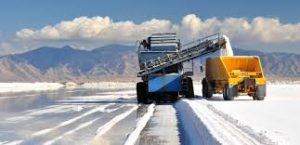Salt is one of the most precious natural compounds known to man. Being the “salt of the earth” or being “worth one’s salt” has long been a compliment. The very word salt comes from the Latin for salary when people were literally paid in salt. Throughout history people have used salt to make bread and more importantly as a vital food preservative to keep bacteria from growing on cured meats and cheeses.
What the ancients may not have realized is just how essential salt (sodium chloride) is for life. It is required for blood, sweat, digestive juices and efficient nerve transmission. In fact a study published in the Journal of the American Medical Association indicated that populations with the lowest salt intakes also have among the shortest life spans.
Salt occurs naturally all over the world as the mineral halite, as well as in seawater and salt lakes. Some salt is on the surface, the dried-up residue of ancient seas like the famed Bonneville Salt Flats in Utah. Ancient sea beds can also be found underground where salt can be mined. And we can make salt from seawater or other salt water sources through evaporation.
lakes. Some salt is on the surface, the dried-up residue of ancient seas like the famed Bonneville Salt Flats in Utah. Ancient sea beds can also be found underground where salt can be mined. And we can make salt from seawater or other salt water sources through evaporation.
Since the early part of the 20th century salt producers have been adding iodine to table salt. This private effort alone has protected countless pregnant mothers and children from iodine deficiency diseases, the world’s leading cause of mental retardation.
The largest use of salt today is for highway winter time safety. Road salt saves thousands of lives and  millions in accident costs, injuries and lost economic activity every year. According to researchers at Marquette University the incidences of accidents, injuries and crashes are decrease by well over 80 percent thanks to road salt. A study conducted by IHS Global Insight found that snowstorms can cost states as much as $700 million per day until roads are cleared.
millions in accident costs, injuries and lost economic activity every year. According to researchers at Marquette University the incidences of accidents, injuries and crashes are decrease by well over 80 percent thanks to road salt. A study conducted by IHS Global Insight found that snowstorms can cost states as much as $700 million per day until roads are cleared.
Like humans, animals naturally seek out salt, an essential nutrient. Most people are familiar with salt licks, but most don’t realize that ranchers add salt to feed, not only because they need it to live, but also because they can control how much livestock will eat based on the level of sodium in the food. If they decrease the amount of salt, cattle will eat more. If they increase the amount of sodium, cattle will eat less. This is because there is a natural appetite for taking in just the right amount of salt.
Salt is also used to condition water to keep the chlorine levels at just the right amount for saltwater pools and to remove calcium and magnesium deposits from household water. These deposits cause hard water which puts a strain on appliances and pipes, decreasing efficiency and increasing repair and replacement costs. Salt will continue to be one of our most essential natural resources.
This article originally appeared at www.saltinstitute.org.
